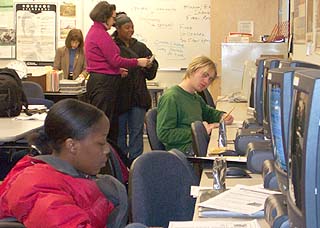
Surveys
DJC.COM
February 28, 2002
Work-site schools teach a lesson to developers
Washington Policy Center

Photo courtesy of Washington Policy Center The Seattle Mall Academy, inside Northgate Mall, is one of about 45 work-site schools in the country. |
As the cost of educating our children continues to rise and the quality of our school system faces increased scrutiny, it is a good time to step back and analyze how the school environment affects our children’s learning.
Kids are influenced by the attitude of their teachers, the quality of the school and the educational opportunities they are provided.
Evidence of the difficulty Seattle Public Schools has in meeting the needs of its students is shown by the high private school enrollment within the district. In Seattle, more than 30 percent of all students choose private schools over the “free” public education system.

Montague |
In an effort to improve the quality of the entire educational experience, school districts throughout the country are establishing innovative work-site schools through public-private partnerships. These partnerships reduce class sizes, increase parental involvement and save money by avoiding the expense of building new schools or renovating old ones.
What are work-site schools?
Work-site schools are programs in which a private company provides the space for classrooms and the school district provides the teachers and textbooks. In exchange for private-sector involvement, these schools offer a targeted enrollment that is designed to serve certain groups of students, like at-risk children or the children of the employees of the sponsoring companies. Because of their proximity to, and partnership with, the business community, these schools also provide valuable internship opportunities for the students.
Parents at work like knowing their children are attending classes down the hall or across the street. In cases of a medical emergencies, parents are close at hand, and their access to after school activities like sports, recitals and parent-teacher conferences, is made much easier.
Today more than 45 satellite, or work-site, schools operate in the United States. Different types of partnerships are developing between businesses and school districts. This idea is already working in our state. The Seattle School District recently joined with the Simon Youth Foundation to create a small high school. The new Seattle Mall Academy is designed to address the needs of at-risk students.
A local success story
The Mall Academy, led by head teacher Eddie Reed, is located at Simon Property Group’s Northgate Mall. The school offers four top-quality educational programs for up to 100 students ages 16-21: Middle College, Applied Health Occupations, Career Ladders and Marketing on the Mall.
All these programs benefit from close partnerships with businesses and organizations located at the mall, allowing students to learn about the professional world first hand through working internships.
The intern positions are not about just ringing up sales. Students work with senior managers to gain leadership skills and experience in running a business. Students attend classes for three hours a day, during which they receive vital instruction in employment skills and career planning, then move on to training and internships at local businesses for the remainder of the day.
The Northgate School is the Simon Youth Foundation’s 15 successful nationwide partnership with a school district interested in developing a model for more responsive education. More information about the foundation and its schools can be found on its Web site at http://syf.simon.com.
The innovation and resources of the Simon Youth Foundation, combined with the willingness of the Seattle School District to seek out private sector involvement, has made possible a unique, positive learning experience for what historically has been a very expensive and difficult-to-educate student population.
Nationwide appeal
School districts around the state should work to develop more of these opportunities. Many school districts throughout the country are benefiting from a new interest in public-private partnerships. These examples of success show how work-site schools can offer innovative educational opportunities for Washington students.
In Des Moines, Iowa, the Downtown Business Alliance joined with the local school district to fund and operate the Downtown School. The Business Alliance donates the space and the school district provides the teachers and administrators. By serving children of parents who work in the downtown business district, the children benefit from close interaction between teachers and parents. Students also learn about local businesses during regular field trips in the downtown area.
Spring Valley Elementary, located at Miami International Airport, illustrates another kind of work-site school. Funded by the local airport authority, the school is popular with parents and has a waiting list of 65 children. Schools such as this help local businesses attract top quality employees because workers know their children will be attending school nearby. Even workers without children have easy access to rewarding volunteer opportunities, like tutoring, mentoring and coaching.
Innovative alternative
Building new schools to house the booming student population is expensive and time consuming. With Seattle Schools facing a $10 million budget deficit for the 2002-03 budget year, it is time to fully explore new alternatives. While continuing with planned new school construction, school districts in Washington can also partner with the private sector to help meet the needs of students.
While alternative work-site schools will not replace traditional public schools, this forward-looking concept provides school leaders and education policymakers with a powerful tool. With greater private sector involvement, school districts can reduce class sizes, increase one-on-one teaching and provide a better education for students.
Eric Montague is a policy analyst at Washington Policy Center, a nonprofit, nonpartisan research and education organization in Seattle. More information is available at www.washingtonpolicy.org.
Other Stories:
- What’s in store for investors in 2002
- 4,000 hours of training to change a light switch?
- Market grows for affordable assisted living
- Beer distributor serves up Arlington
- 2,158 reasons to like nonprofit housing groups
- Regulation reform can help jump-start the region
- Condo legislation creates legal slugfest
- A tale of two cities’ downtowns
- Managing churn without feeling the burn
- Workplace design can improve productivity
- Spokane: A study in steady growth
- Recession? Don’t worry, it’s just a cycle
- Leasehold title insurance: New ALTA endorsements
Copyright ©2009 Seattle Daily Journal and DJC.COM.
Comments? Questions? Contact us.